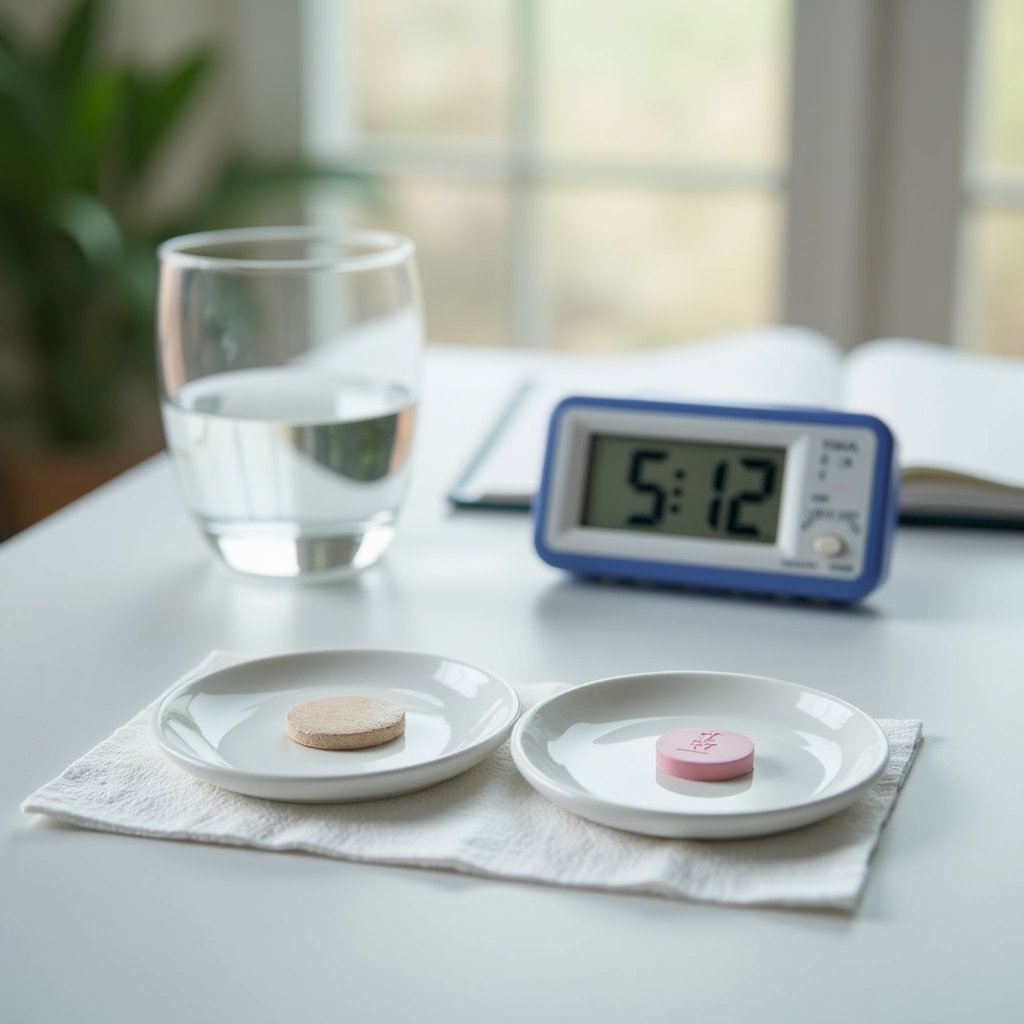Suboxone films dissolve faster (5-7 minutes) than tablets (7-12.4 minutes) and provide twice the bioavailability, meaning you’ll need lower doses for equivalent effects. Films bypass primary metabolism for quicker therapeutic onset, while maintaining more consistent blood levels. Though both forms are clinically effective, your choice may depend on practical factors like discretion (tablets are smaller) and comfort (films leave less aftertaste). Your unique treatment needs and lifestyle will help determine which option best supports your recovery expedition.
Understanding Absorption Differences Between Films and Tablets

Three key factors distinguish Suboxone film absorption from tablet absorption: dissolution speed, bioavailability, and absorption rate. Films dissolve within minutes due to amplified moisture absorption and direct contact with sublingual tissue, while tablets take dramatically longer and may leave residue. Suboxone strips are engineered to dissolve up to 6.6 minutes under the tongue. Both formulations are considered clinically interchangeable for treating opioid use disorder. You’ll experience quicker therapeutic effects with films since they bypass primary metabolism. Peak effects typically occur 2-3 hours after administration regardless of the formulation.
Films achieve double the bioavailability of tablets, meaning you need lower doses to achieve equivalent effects. This improved efficiency helps minimize dosage fluctuations and maintains more consistent blood levels. When you place a film under your tongue, it enters your bloodstream within minutes, compared to tablets that may take 30+ minutes for full absorption. This faster initiation can help reduce withdrawal symptoms more quickly and provide better symptom management throughout your treatment.
Breaking Down the Dissolution Process

The dissolution process marks a fundamental difference between Suboxone films and tablets, with distinct timelines affecting therapeutic outcomes. You’ll notice films dissolve rapidly, taking just 5-7 minutes compared to tablets’ 7-12.4 minutes. This difference in effective dissolution properties directly impacts how quickly you’ll receive relief. Both forms contain buprenorphine and naloxone to help manage opioid dependence effectively.
When you place either form under your tongue, your saliva levels will influence dissolution speed, but films consistently demonstrate superior performance. While older tablet versions left residue, newer formulations dissolve more cleanly. Lower abuse rates are associated with film formulations since they cannot be crushed and inhaled like tablets.
Films’ slim design and optimized formulation guarantee ideal drug delivery through complete dissolution, leading to 2× greater bioavailability than tablets. This heightened absorption means you’re getting more efficient delivery of the medication into your system.
Patient Experience and Comfort Factors

You’ll notice distinct differences in taste and residual sensation between Suboxone films and tablets during treatment, with films generally leaving less lingering aftertaste. When taking your medication in public settings, tablets offer more discretion due to their smaller size and less conspicuous administration process.
Your comfort level with either form may substantially impact treatment adherence, as films dissolve faster but are more visible during use, while tablets take longer to dissolve but draw less attention. Both administration methods are equally effective in managing opioid dependence, so your choice should focus on which format best suits your lifestyle and preferences. Studies show that films provide faster absorption rates compared to tablets, which can be particularly beneficial for those experiencing acute withdrawal symptoms.
Taste and Residue Differences
When comparing Suboxone films and tablets, distinct differences in taste profiles and residual effects noticeably impact patient comfort and compliance. Your perceptual sensitivities and individualized taste preferences will influence which format you find more tolerable. While both forms contain inherently bitter active ingredients, films typically incorporate citrus flavoring systems to mask the taste. The protein binding rate of each component affects how the medicine is processed and experienced in the body. Both forms of Suboxone are considered equally effective in treating opioid addiction.
| Feature | Films | Tablets |
|---|---|---|
| Dissolution | Rapid sublingual | Standard oral |
| Aftertaste | Stronger, citrus | Milder, basic |
| Residue | Minimal film coating | Potential throat feel |
You’ll find films dissolve faster under your tongue, leaving minimal residue but potentially stronger aftertaste. Tablets, while requiring traditional swallowing, often present a milder taste profile. Clinical trials show newer tablet formulations like Zubsolv demonstrate improved taste ratings, though individual experiences vary considerably with repeated use.
Ease of Public Use
Beyond taste considerations, public medication management shapes daily life for Suboxone users, with distinct advantages emerging between film and tablet formats.
When you need discreet consumption, films offer significant benefits. They dissolve 3-5 times faster than tablets, reducing the time you’ll spend administering medication. Their thin, foil-wrapped design allows for unobtrusive dosing and easier transport in wallets or small bags. You won’t need water for administration, and the rapid dissolution minimizes jaw fatigue in social settings.
While tablets are more affordable ($40-$60 monthly versus $65-$85 for films), they present challenges in public spaces. They may crumble, require longer dissolution times, and leave residue. Their packaging can also draw unwanted attention, potentially compromising your privacy during necessary medication management.
Comparing Clinical Results and Effectiveness
Clinical studies have zeroed in on the therapeutic equivalence between Suboxone films and tablets, revealing no significant differences in their effectiveness for managing opioid dependence. Healthcare provider expertise and extensive clinical research trials confirm that both formulations deliver comparable results when properly administered. Buprenorphine-naloxone films are increasingly preferred by healthcare providers due to their enhanced safety profile and convenience.
Key findings demonstrate equivalent performance in:
- Opioid withdrawal symptom management and craving reduction
- Buprenorphine/naloxone absorption rates and bioavailability
- Blood plasma concentration levels and duration of therapeutic impact
- Comprehensive treatment success rates and patient retention
You’ll find that modern versions of both films and tablets have been optimized for effective delivery, making your choice more about personal preference than clinical superiority. While films may dissolve slightly faster, this doesn’t translate to better treatment outcomes, as confirmed by current medical evidence.
Navigating Treatment Costs and Insurance Coverage
When choosing between Suboxone film and tablets, you’ll find that insurance coverage varies considerably, with generic tablets covered by about 82% of Medicare Part D plans while brand-name film coverage depends on specific plan contracts.
Major health insurance providers like Aetna and TRICARE commonly include Suboxone coverage in their prescription drug plans. You’ll typically encounter lower out-of-pocket costs with generic tablets ($100-200/month) compared to Suboxone film (over $500/month before insurance), though your actual expenses will depend on your insurance plan’s copays and requirements. The shift away from brand-name Suboxone film has led to a substantial decrease in estimated out-of-pocket costs. Most Medicare prescription drug plans offer Suboxone coverage with copays up to $120 depending on your coverage stage.
Your provider can help you navigate insurance considerations like prior authorizations, step therapy protocols, and quantity limits that may affect your access to either formulation.
Insurance Plan Coverage Comparison
Although both Suboxone film and tablets are widely covered by insurance plans, maneuvering coverage options requires careful consideration of several factors. Most major insurers, including Aetna, Blue Cross, and Medicare Part D, typically favor generic tablets over brand-name films due to cost differences. Clinical studies have shown that both formulations demonstrate equal effectiveness in treating opioid dependence. You’ll need to verify pharmacy prior authorization requirements and coverage policy changes with your specific insurer, as these can vary markedly.
Generic tablets often have broader coverage and fewer authorization hurdles, costing $100-200 monthly versus $500+ for films. Over 80% of Medicare Part D plans now cover generic buprenorphine/naloxone films. Some patients may find that using pharmacy coupons provides better savings than their insurance coverage. Your pharmacy may stock only one formulation, requiring advance verification. Prior authorization is more commonly required for brand-name films than generic tablets, potentially affecting treatment initiation.
Out-of-Pocket Cost Analysis
Understanding out-of-pocket expenses for Suboxone treatment reveals significant cost variations between films and tablets. When budgeting treatment costs, you’ll find tablets typically cost $25-$45 for a 14-day supply, while films range from $40-$80. Your medication affordability options expand with generic alternatives, offering up to 70% savings.
| Format | 14-Day Cost | Monthly Cost | Savings Options |
|---|---|---|---|
| Tablets | $25-$45 | $90-$240 | GoodRx, Coupons |
| Films | $40-$80 | ~$168 | Patient Assistance |
| Generic Films | $25-$35 | $51.26 | Pharmacy Rewards |
You can reduce your out-of-pocket expenses through manufacturer coupons, GoodRx discounts, or patient assistance programs. While films have a higher upfront cost, their dosing flexibility may provide better value by reducing waste. Generic films offer the most cost-effective option at $51.26 for a monthly supply.
Exploring Available Dosage Options
Suboxone’s dosage options span both film and tablet formulations, with maintenance doses typically ranging from 4 mg/1 mg to 24 mg/6 mg buprenorphine/naloxone daily. When considering dosage optimization strategies, you’ll find films offer more flexibility for precise dosage timing adjustments through multiple strength options and the ability to split doses.
Suboxone films provide greater dosing flexibility than tablets, with multiple strengths allowing precise adjustments to meet individual treatment needs.
Key differences in available dosage options include:
- Films come in 2/0.5 mg, 4/1 mg, 8/2 mg, and 12/3 mg strengths, allowing for finer dose adjustments
- Tablets are limited to 2/0.5 mg and 8/2 mg strengths, offering fewer combination possibilities
- Films can be administered both sublingually and buccally, providing route flexibility
- Maximum daily doses reach 24 mg/6 mg for films, while tablets may accommodate higher doses in specific cases
Your healthcare provider will help determine the most appropriate formulation based on your individual needs.
Making the Switch: Transitioning Between Forms
When shifting between Suboxone forms, you’ll need to work closely with your healthcare provider to guarantee a seamless conversion that upholds therapeutic effectiveness. Several product selection factors will influence your change, including your comfort with sublingual administration and oral sensitivity.
Research shows both formulations maintain comparable blood levels and treatment outcomes, though you may need slight dose adjustments when switching to films due to their higher bioavailability. The formulation characteristics between tablets and films differ primarily in dissolution speed and texture – films typically dissolve faster and leave less residue.
If you’re considering a switch, you’ll find encouragement in clinical data showing over 90% retention rates for patients moving to films, with no increased risk of relapse or treatment disruption.
Storage and Transportation Considerations
The proper storage and transportation of Suboxone demands careful attention to environmental factors that can impact medication stability. To optimize shelf life, you’ll need to maintain both films and tablets between 59°F-86°F in airtight containers away from light exposure. While films are particularly vulnerable to heat and humidity, tablets offer slightly better resilience during transport.
Store your medication in a dark, temperature-controlled drawer away from bathroom steam. Transport medications in an insulated container when temperatures might exceed 86°F. Keep products in their original, opaque packaging to protect from UV degradation. Check expiration dates monthly and follow disposal recommendations for compromised medication.
Long-Term Treatment Success Rates
Beyond proper storage practices, understanding long-term treatment outcomes helps patients and providers make informed decisions about Suboxone therapy. You’ll find higher medication adherence rates when receiving ideal dosing (30-32 mg/day) combined with behavioral counseling, resulting in 60% retention at 6 months.
| Success Metric | Film | Tablets |
|---|---|---|
| Patient Satisfaction | High portability | Traditional format |
| Adherence Support | Dissolution tracking | Standard monitoring |
| Risk Reduction | Lower diversion risk | Standard safeguards |
Your chances of maintaining recovery increase considerably with either formulation when you participate in thorough treatment. Both forms demonstrate positive outcomes in reducing relapse risks and improving quality of life. You’ll experience better results when combining your medication with counseling, maintaining proper dosing schedules, and engaging in support services that enhance your treatment journey.
Frequently Asked Questions
Can Pregnant Women Safely Use Suboxone Films or Tablets?
Yes, you can safely use either Suboxone films or tablets during pregnancy when prescribed as part of your prenatal care coordination. Both forms are comparably effective and safe for managing opioid use disorder while pregnant.
Your healthcare provider will monitor and adjust your Suboxone dosage throughout pregnancy to guarantee ideal treatment. While your baby may experience some withdrawal symptoms after birth, these are typically milder compared to other opioid medications.
How Long Should I Wait After Eating Before Taking Suboxone?
You should wait at least 15 minutes after eating or drinking before taking Suboxone, following the “Rule of 15.” Some healthcare providers recommend waiting up to 30 minutes to safeguard maximal absorption.
This timing of dosage is critical because food interactions can interfere with how well the medication absorbs through the mucous membranes under your tongue. After taking Suboxone, you’ll also need to wait 15-30 minutes before eating or drinking again.
Can I Drink Alcohol While on Suboxone Treatment?
You shouldn’t drink alcohol while taking Suboxone due to dangerous medication interactions. Concurrent substance abuse creates serious risks, including severe central nervous system depression, respiratory failure, and potential death.
Even small amounts of alcohol can amplify Suboxone’s effects, leading to excessive sedation and impaired coordination. The combination can also interfere with your recovery goals and increase your risk of relapse.
Always discuss any substance use with your healthcare provider.
What Happens if I Accidentally Swallow the Film or Tablet?
If you accidentally swallow your Suboxone, don’t panic – it’s not typically dangerous, but it will be less effective. Swallowing considerably reduces the absorption rate compared to sublingual administration, as the medication gets broken down by your digestive system.
This lower bioavailability might lead to withdrawal symptoms since you’re not getting the full therapeutic dose. While you should continue your regular dosing schedule, try to be more mindful of keeping future doses under your tongue until fully dissolved.
How Do I Dispose of Unused Suboxone Films or Tablets?
For proper disposal of unused Suboxone, you should initially use medication takeback programs at DEA-authorized locations or drug take-back kiosks. If these aren’t available, consider using prepaid mail-back envelopes.
Since Suboxone is on the FDA’s flush list, you can flush it immediately if other options aren’t accessible. As a last resort, mix with coffee grounds or kitty litter, seal in a plastic bag, and dispose in household trash.






